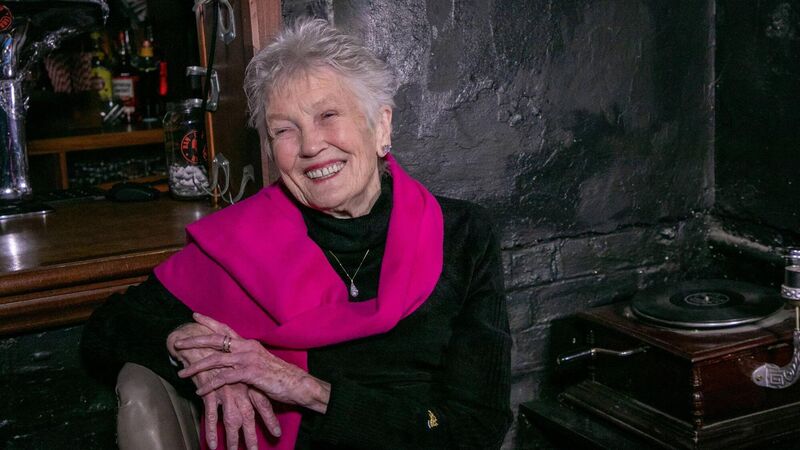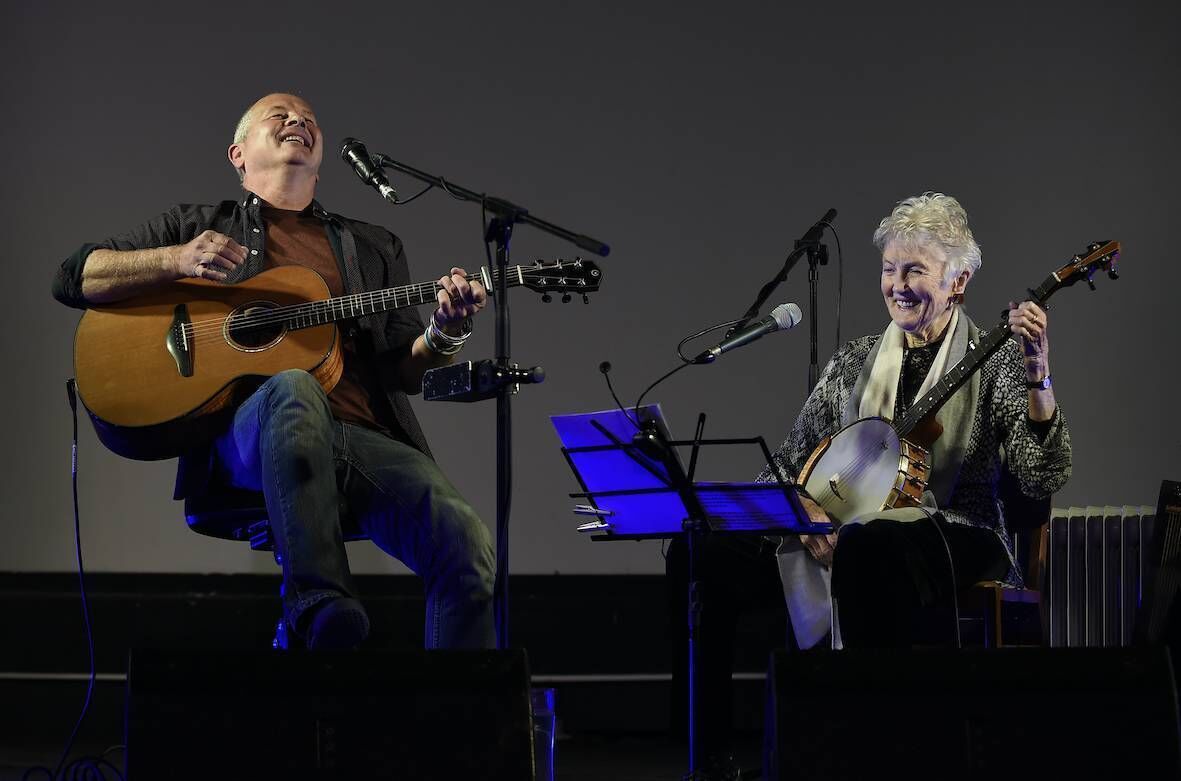Peggy Seeger: The US folk legend on Ireland in the 1950s and an incredible life in music

Born in 1935, Peggy Seeger grew up in New York, part of American folk music royalty. Picture: Vicki Sharp.
The first time Peggy Seeger came to Ireland was in the summer of 1956. She was visiting as a companion of Diane Hamilton, the heiress to the Guggenheim dynasty who was travelling around Ireland recording folk singers and collecting trad songs. Over three or four weeks, they visited the McPeake family, Paddy Tunney and Sarah Makem, among other famous Irish traditional music houses.
“Ireland was very different then,” says Seeger. “Parts of it were a century back. There were still towns that had dirt roads running through them, and houses that were below the pavement of the road. Women came out to their half-doors, leaned out of them and talked. I was 21, so you can imagine what that meant to me.”
Born in 1935, Seeger grew up in New York, part of American folk music royalty. Her father was a pioneering musicologist. Seeger’s half-brother, a son from her father’s first marriage, was Pete Seeger, the legendary singer-songwriter and activist. He was 16 years older than her. When he visited her house, he sang songs to herself and her siblings he’d learned while touring the world.
There were many famous houseguests when she was growing up. Woody Guthrie arrived one day with Leadbelly, who’d only recently been released from jail. Guthrie used to trail his guitar around behind him like a dog. When she was 10, Jackson Pollock dropped by. He spread paint all over a canvas and urged herself, her sister and brother, to walk in it. Her mother was livid because they dragged paint all over the house.
Seeger’s mother, Ruth Crawford Seeger, was an avantgarde composer and the first woman to receive a Guggenheim Fellowship for composition. She died when Seeger was 18, but still looms large in her consciousness. She taught Seeger the piano from the age of six, and music theory. Seeger could transcribe music aged 11.
“My mother made me into a really good piano player, making me practice scales and things like that, but she also taught me to have fun on the piano,” she says. “I don't play classical music anymore because I've lost my hands to arthritis.”
Seeger’s mother worked with Alan and John Lomax, the famous folk music collectors. She transcribed the songs they gathered so they could be put in schoolbooks. Those songs, playing in the background, became a soundtrack to Seeger’s childhood. It’s no surprise she fell in love with folk music.
Seeger moved to the Netherlands in 1955, where she studied Russian. She then hitchhiked around Europe for a year. She visited the Soviet Union, and became one of the first American civilians to enter the People’s Republic of China after its Communist revolution (which put her in the CIA’s crosshairs). She even had dinner with Mao Zedong.
“My father never told me, ‘You can't do this; you can't do that’,” she says. “My mother dressed me in trousers when I wanted. I climbed trees. I rode a bicycle. I took roller-skates to school. In music, nobody said, ‘You can't play a double bass. You can't play a tuba.’ Men took easier to big musical instruments than women did back then. Women now play any instrument.
“If you look at pop groups, men were whacking guitars, women were singing. That's what we were told to do. People told me, ‘You can't play the banjo – that’s a man's instrument.’ I said, ‘Why?’ They said, ‘Because you have to spread your legs to play it.’ And that was not ladylike. If there was a woman harp player – until quite recently – they put a shield in front of the lower part of her body so just her fingers were showing.”

On a trip to London in spring 1956, she met the playwright, folk singer and socialist firebrand Ewan MacColl, who was in his second marriage and 21 years older than her, at a folk group audition. “At 10.30am, banjo in hand, I tottered in on my high heels to meet my next 33 years,” she wrote in her memoir, First Time Ever, which takes its title from MacColl’s song, 'The First Time Ever I Saw Your Face'. (See panel.)
Seeger and MacColl had three children together. (Seeger was also step-mother to Kirsty MacColl, a daughter from MacColl’s second marriage.) They spearheaded the British folk revival, criss-crossing the British Isles collecting songs and gigging; releasing records on their label, Blackthorne; broadcasting the landmark BBC radio documentary series, The Radio Ballads, which captured the spirit of working classes at work; and held court at the Singers’ Club, where Bob Dylan and Luke Kelly, both on the way up, performed in the early 1960s.
“Luke was actually a good singer at that time,” she says. “When he joined The Dubliners, he began to sing too loud. He had a delicate ability to sing and he lost that with The Dubliners when he did different music.”
Seeger, who turns 90 in June, is in Dublin this week for the twentieth anniversary of TradFest, joining Moya Brennan, Maura O’Connell, Ralph McTell, and other trad stars, in a bumper line-up. Seeger will be in conversation and will also perform three songs, including her feminist anthem I’m Gonna Be An Engineer.
“Ewan McCall and I, working for the BBC and for the National Coal Board, used to visit a lot of engineering factories,” she says. “In Corby, England, they had these big, incredible machines that made machine parts. There was this fantastic woman we interviewed who could bring a thousand-ton hammer right down exactly to the millimetre, knowing just when to stop it.
“I wrote the song for her. I was so impressed. I'd never seen a woman running machines like this. This was the early 1960s. Ever since we've had patriarchy, which runs the world now, women have been told, ‘You can't do this or that. You're the weaker sex.’ That’s why I made that song up. That’s why women cotton onto the song.”
- Peggy Seeger will be in conversation at TradFest, 8pm, Thursday, Áras Chrónáin Ionad Cultúir, Clondalkin, Dublin. Visit www.tradfest.com for tickets.
Ewan MacColl wrote 'The First Time Ever I Saw Your Face', one of the twentieth century’s great ballads, for Peggy Seeger in 1957. It was a year into their courtship. They were oceans apart at the time – MacColl was in England, Seeger in the United States.
In 1972, a huge cheque, $75,000, landed in the door from Roberta Flack’s management team, royalties from her Grammy Award-winning cover version. The R&B singer had recorded the song in 1969, but it didn’t catch fire until featuring in Clint Eastwood’s directorial debut film, Play Misty for Me.
The song has been covered by the Great and the Good, including Johnny Cash, George Michael and Elvis. MacColl wasn’t impressed by the King’s version, remarking that he sounded like “Romeo at the bottom of the Post Office Tower singing up to Juliet”.
The song is also a staple of Seeger’s repertoire. When MacColl died in 1989, Seeger didn’t sing the song again for another 15 years. It was too painful.
In 2006, however, Seeger married her long-time lover, Irene Pyper-Scott. In love again, the song took on new meaning. She sang it with a different spin, less cautiously.



